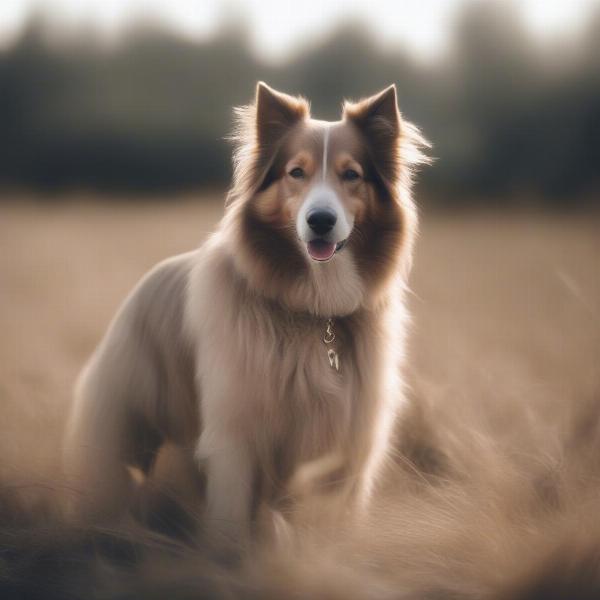Naked dog food, often referring to raw or minimally processed diets, has gained significant popularity among dog owners seeking a more natural approach to canine nutrition. This comprehensive guide will explore the benefits, risks, and practical considerations of feeding your dog a naked food diet. We’ll delve into the different types of naked dog food, discuss nutritional needs, and provide tips for transitioning your dog safely and effectively.
Understanding Naked Dog Food
What exactly does “naked” mean in the context of dog food? It essentially signifies a diet closer to what a dog’s ancestors would have consumed in the wild. This can include raw meat, bones, organs, fruits, and vegetables, or minimally processed versions of these ingredients. The idea behind naked dog food is to provide a diet rich in natural nutrients and free from artificial additives, fillers, and preservatives often found in commercial kibble.
Benefits of Naked Dog Food
Many proponents of naked dog food report several potential benefits, including improved coat and skin health, increased energy levels, better digestion, and stronger immune systems. Some believe that a raw diet can also contribute to healthier teeth and gums, as the chewing action on raw bones can help remove plaque and tartar.  Shiny Dog Coat
Shiny Dog Coat
Risks and Considerations of Naked Dog Food
While the potential benefits are appealing, it’s crucial to acknowledge the potential risks associated with naked dog food, particularly raw diets. Raw meat can contain harmful bacteria like Salmonella and E. coli, posing a risk to both dogs and humans handling the food. Nutritional imbalances can also occur if the diet isn’t carefully formulated to meet a dog’s specific needs. Bones, while beneficial for dental health, can also present a choking hazard or cause digestive issues if not fed appropriately. naked essentials dog food
Nutritional Needs and Balancing a Naked Diet
Ensuring a balanced naked diet is essential for your dog’s health. This involves providing the right proportions of protein, fat, carbohydrates, vitamins, and minerals. Consulting with a veterinary nutritionist is highly recommended, especially when transitioning to a raw diet. They can help you create a customized meal plan that meets your dog’s individual needs and minimizes the risk of nutritional deficiencies.
Transitioning to Naked Dog Food
If you decide to transition your dog to a naked food diet, do it gradually to avoid digestive upset. Start by introducing small amounts of the new food alongside their current diet, slowly increasing the proportion of naked food over several days or weeks. Monitor your dog closely for any signs of digestive issues, allergies, or other adverse reactions. chicago dog relish
Types of Naked Dog Food
Naked dog food encompasses a spectrum of diets, from completely raw to minimally processed. Some common options include:
- Raw Diets (BARF – Biologically Appropriate Raw Food): These diets typically consist of raw muscle meat, bones, organs, and small amounts of fruits and vegetables.
- Pre-Made Raw Diets: Commercially available frozen or freeze-dried raw food blends offer a more convenient alternative to preparing raw meals from scratch.
- Minimally Processed Diets: These diets often use gently cooked or dehydrated ingredients, preserving more nutrients than traditional kibble. raw dog
Is Naked Dog Food Right for Your Dog?
Choosing the right diet for your dog is a crucial decision. Naked dog food, whether raw or minimally processed, can be a viable option, but it requires careful planning, preparation, and monitoring. Weigh the potential benefits and risks, consult with your veterinarian, and consider your dog’s individual needs and lifestyle.
Conclusion
Naked dog food offers a natural approach to canine nutrition, potentially providing several health benefits. However, it’s essential to be aware of the potential risks and to proceed with caution. By understanding the different types of naked dog food, the importance of balanced nutrition, and the proper transition process, you can make an informed decision about whether this dietary approach is suitable for your canine companion. Remember, a healthy diet is key to a happy and vibrant dog. Always consult your veterinarian before making any significant changes to your dog’s diet. toothache dogs symptoms
FAQ
- Is raw dog food safe? Raw dog food carries the risk of bacterial contamination. Proper handling and preparation are crucial to minimize this risk.
- What are the signs of a nutritional deficiency in dogs? Signs can vary but may include skin problems, dull coat, lethargy, and digestive issues.
- How do I transition my dog to a raw diet? Transition gradually over several weeks, introducing small amounts of raw food alongside their current diet.
- What if my dog doesn’t like raw food? Not all dogs readily accept a raw diet. Experiment with different ingredients and textures.
- Is naked dog food more expensive than kibble? Naked dog food can be more expensive, especially commercially prepared raw diets. huge dog pool
- Can puppies eat naked dog food? Yes, but it’s crucial to ensure the diet is specifically formulated for growing puppies.
- Where can I find a veterinary nutritionist? Ask your veterinarian for a referral to a board-certified veterinary nutritionist.
ILM Dog is a leading international website dedicated to providing dog owners worldwide with reliable, practical advice on all aspects of dog care. We cover everything from breed selection and healthcare to training, nutrition, grooming, and much more. Our team of experts is passionate about helping dogs thrive and live their best lives. For expert guidance on dog nutrition and other aspects of dog care, contact us at [email protected] or +44 20-3965-8624. ILM Dog is here to help you navigate the world of dog ownership with confidence.